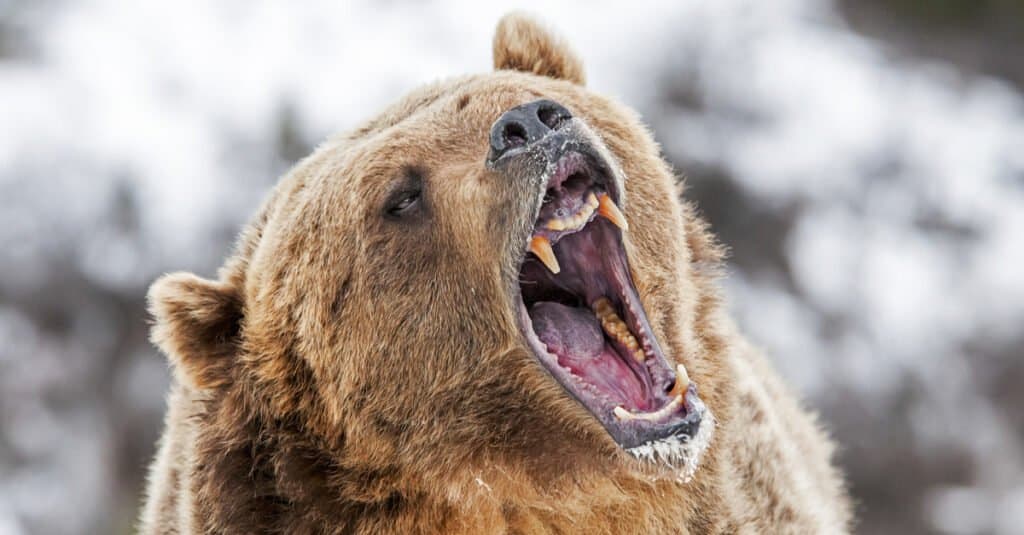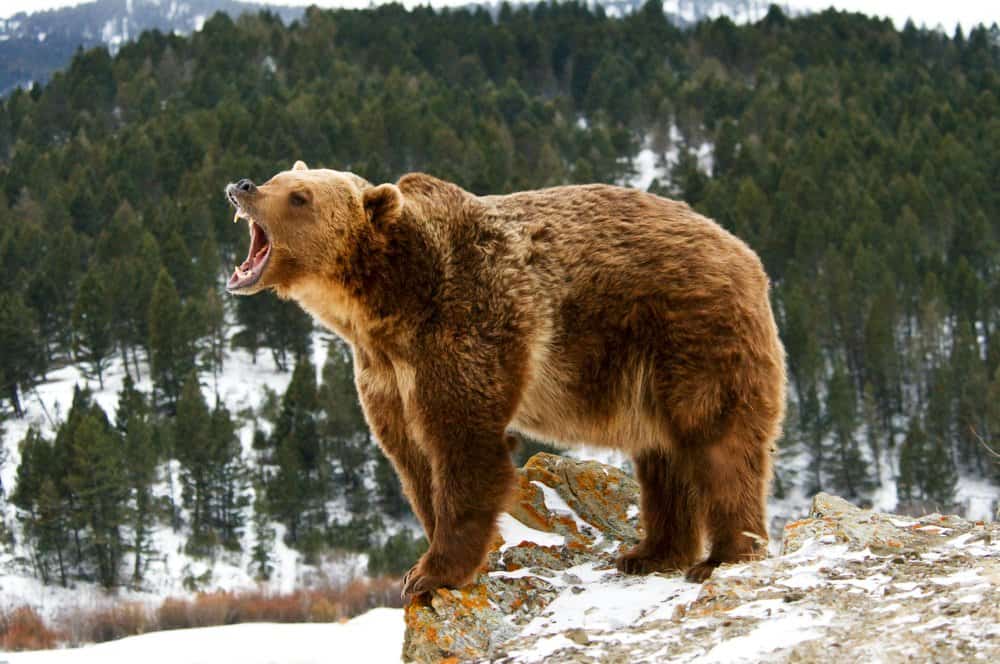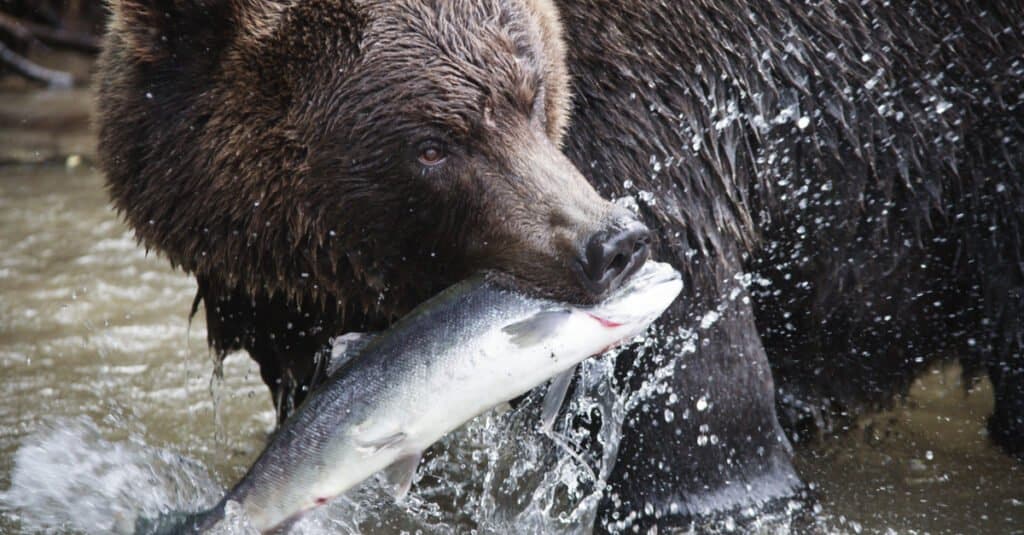In North America, grizzly bears are one of the most dangerous animals you can come across. Large and fluffy, some may think they are cute, but these furballs are incredibly deadly. Grizzly bears are a subspecies of brown bears, which are the second-largest bears in the world. The Kodiak bear is the largest subspecies of brown bears and gets close to the size of a polar bear.
Grizzly bears are beautiful brown beasts and have an extensive range covering a large amount of western North America, but they have declined significantly within the past decades. In the U.S., grizzlies have declined considerably, but the animal is still very beloved. Around 55,000 grizzly bears are still present. Grizzly bears have a powerful bite force and are one of the largest predatory mammals in North America. In this article, you will learn about the Grizzly Bears’ bite force and how dangerous they can be.
What Is The Bite Force Of A Grizzly Bear

Bear with its mouth open
©Scott E Read/Shutterstock.com
Grizzly bears have a strong bite of 975 PSI, which ranks alongside some of the strongest animals in the world. The polar bear and other brown bears species have the strongest bite force amongst bears. These animals are extremely large and are also some of the strongest bear species. Larger bears have a stronger bite force and are much stronger, with polar bears having bite forces that can reach 1,200 PSI.
Grizzly Bear Size and Impact on Bite Force

Grizzly roaring on mountain
©Scott E Read/Shutterstock.com
Grizzly bears can be extremely large animals, but their size will vary depending on the specific bear. These bears can weigh more than 700 pounds, but females are smaller and usually weigh around 300 to 400 pounds. Grizzly bears living in coastal regions are larger than other grizzlies inland. On average, they are approximately 6.5 feet tall, but the largest are said to be up to 11 feet tall.
The Kodiak bear is the largest brown bear and is considered one of the largest bears in the world. Some Kodiak bears can grow as large as the polar bears, but both species are gigantic. The largest polar bear ever weighed 2209 pounds and was shot in Alaska, standing almost 12 feet tall. Kodiak bears in the wild can reach up to 1500 pounds and maybe larger. The largest Kodiak bear on record weighed 1,656 pounds.
Bears in colder regions are usually bigger to help them stay warm. Brown bears like the grizzly or Kodiak bears are not primarily carnivores like polar bears, as plants are essential for their diet. Polar bears grow larger in part because they eat mostly meat, but also because inhabit the coldest areas of the world.
If a grizzly bear gets large enough, its bite force may be stronger than 975 psi. Grizzly bears are omnivores, eating meat and plant life. Their great bite force and size make them heavy eaters and dangerous predators to come across in the wild, with a powerful bite.
Grizzly Bear Diet

Large adult bears can eat more than 30 fish daily.
©DPS/Shutterstock.com
Grizzly bears are omnivores, and their diet consists of what is available in their habitat. Some of the things a grizzly bear eats include:
Grizzly bears will hunt small animals like fish, rodents, and insects. Deer and moose are also a part of their diet, but they are harder to catch and constitute a small part of their diet. A bear is strong enough to take out large animals with its strong claws and strong bite force. The bear kills larger prey by biting into its vital areas and can hold down animals with their large size. Their claws are long to help hold onto prey and dig holes to hibernate in the winter. Grizzly bears are not the best hunter like big cats or wolves, so they are more likely to eat more sick and wounded animals than healthy ones.
Grizzly bears eat plant life and even grass in the areas they inhabit. Plant life is a considerable part of the grizzly bear’s diet, making up around 85% of what they eat. Before hibernating, they will eat nonstop, eating up to 90 lbs of food a day. They can almost double in size, which helps them survive the winter.
Grizzly bears have a balanced diet, but some bears like the panda are vegetarian. Polar bears are the opposite and survive primarily on meat. Grizzly bears rely on both, but their strong bite makes it easier for them to rip into animal flesh.
Are Grizzly Bears Dangerous
Grizzly bears are extremely dangerous animals because of their deadly bite and large size. Attacks on humans are rare, but they can happen if you wander into their territory. Grizzly bears may attack if they have cubs or smell food. Grizzly bears are extinct in a large area of their range within the U.S. and are rare to find. In the continental United States they’re only found in Washington, Idaho, Montana, and Wyoming today. Most of the U.S. grizzly population is found in Alaska.
If you are hiking or live near a grizzly bear’s range, they may attack you if they feel threatened. Bears will often attack in self-defense and rarely attack humans. There are about 11 attacks from brown bears in the United States annually. Grizzly bears are amazing fluffy animals and are some of the most beloved species in North America. Yet, a powerful bite and deadly size make you want to avoid these giant mammals.
The photo featured at the top of this post is © Alexandra Giese/Shutterstock.com
Thank you for reading! Have some feedback for us? Contact the AZ Animals editorial team.






